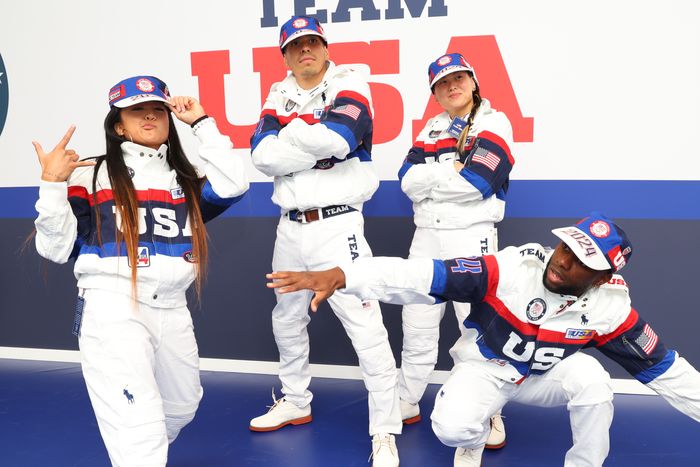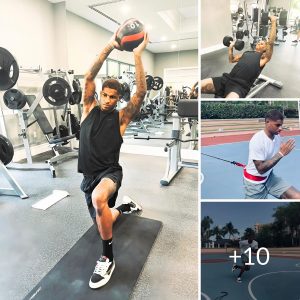BREAKING: An Olympic Breaking Breakdown

The U.S. Olympic breaking team. Photo: Joe Scarnici/Getty Images for USOPC
Call it breaking news — B-boys and B-girls are battling it out as breaking (not breakdancing) makes its official debut as an Olympics event, with the women’s and men’s events respectively taking place on August 9 and 10 in La Concorde, the urban park where the BMX freestyle and skateboarding competitions were held in Paris. Of course, global competitions are nothing new for breakers; the roster for the 2024 Olympics includes both reigning winners of the WDSF’s World Breaking Championship, Victor “B-Boy Victor” Montalvo of the United States and Dominika “B-Girl Nicka” Banevič of Lithuania. But what if you’re tuning in as someone who doesn’t know your windmills from your backspins?
“If you get one thing out of this, understand that you’re watching the purest form of hip-hop,” says Luis “Prevail” Toledo, a New York–based breaker who has been dancing for 22 years and reps the Mighty Zulu Kingz, One Society, and Fresh Descendants crews. Below, a breakdown of the breaking basics, including why it’s not “breakdancing,” how the events will be judged, when and where to tune in live, and its origins in hip-hop.
Breaking originated in Black and brown communities in the Bronx as an outlet amid tense gang rivalries in the 1970s. Early practitioners “had no escape from anything, so they wanted to dance it out through battles instead of actually having to fight,” explains Toledo. The name comes from the “break,” or the percussive standout part of a song. When hip-hop founding father DJ Kool Herc noticed that people were going off on the dance floor during the breaks, he figured out how to extend those parts. (He’s also credited with coming up with the terms “B-boy” and “B-girl.”)
The main elements of breaking have pretty intuitive titles: Toprock refers to moves you do while standing up, downrock is what you do while you’re on the floor, freezes are when you hit and hold an often gravity-defying pose, and power moves include acrobatic motions like spins.
Do what you want … but just know that some breakers will probably be rolling their eyes. “Breakdancing” is a word that was popularized by the media and sometimes incorrectly used to describe other street-dance styles, so it can represent an unwelcome simplification and commercialization to those who are protective of breaking culture. Victor “B-Boy Victor” Montalvo, a gold-medal favorite for the U.S. in the men’s event, told Today that the media-made term has been considered “corny.” You might even get a nickname if you use it: “They call them toys, people that don’t know anything about the dance.”

Luckily, there’s no need to wrap your head around a complicated points system. After a round-robin qualifier, breakers will battle each other in best-of-three rounds called “throwdowns,” where they’ll get up to 60 seconds to improvise a routine to beats by New York’s DJ Fleg or Poland’s DJ Plash. During these one-on-one matchups, a panel of nine judges will move digital sliders in real time toward the side of whichever breaker they think is doing better in each of five different categories established by the WDSF:
- Originality: How creative the moves are. A routine should showcase style and personality — and definitely not “bite” someone else’s moves.
- Technicality: The skill level of the moves, which can be assessed by factors like athleticism and body control.
- Vocabulary: The variety and amount of moves. A routine shouldn’t feel too repetitive or empty.
- Execution: How cleanly the moves are performed (hopefully, there’s no slipping or tripping).
- Musicality: How well the moves match up to the music.
Each category is worth 20 percent, which means it is equally as important to, say, show off some advanced power moves as it is to be listening to the music and hitting the rhythm of the beats or specific instruments. That’s where the artistic part of this sport comes in — winning is not only about being the quickest or strongest.
With a play-by-play by David “Kid David” Shreibman and analysis by Ronnie “B-Boy Ronnie” Abaldonado, NBC’s Olympics coverage should have enough commentary to help explain any concepts that might not be as obvious to a newbie, like how difficult a specific footwork sequence is or whether that breaker had good form when they were upside down doing a head spin on the floor.
The United States has two B-girls and two B-boys battling at the Olympics this year. In the women’s event, we’ve got 35-year-old Sunny “B-Girl Sunny” Choi and 21-year-old Logan “Logistx” Edra. Victor “B-Boy Victor” Montalvo, 30, and Jeffrey “B-Boy Jeffro” Louis, 29, will represent Team USA in the men’s event. In total, 16 men and 16 women will compete this year, representing more than a dozen countries.
Breaking is becoming an official event six years after a strong showing at the Summer Youth Olympics in Buenos Aires, Argentina. It’s not on the schedule for L.A. 2028, but there’s still hope that a successful introduction in Paris could help it return for the 2032 Games.
Although some breakers have expressed concerns that becoming an Olympic event waters down the artistic spirit and culture of street battles and block parties, others see it as a good thing that breaking is going to gain more recognition as a sport on the world stage. “I think it’s needed,” Toledo says of the event’s Olympics debut. “I’m happy and grateful for the people that are up there doing it.” Everyone seems to know each other in some way or form in the tight-knit breaking community. (For example, Toledo often practices two to three times a week with Sunny Choi, the B-girl from Queens who was the first woman to qualify for the U.S. breaking team; he also hangs out with B-boy gold-medal favorite Montalvo every time they’re at the same events.) As someone who has no Olympic aspirations and organizes community practices and events, judges battles, and competes at the grassroots level, Toledo believes the increased attention on breaking will translate to more opportunities for him, too.
Tune in on Peacock or NBCOlympics.com to watch the two-day competition, which will stream live. The current event schedule, with all times in ET, is listed below.
Friday, August 9
10 a.m.–12:10 p.m.: Women’s qualification
2 p.m.: Women’s quarterfinal 1
2:07 p.m.: Women’s quarterfinal 2
2:14 p.m.: Women’s quarterfinal 3
2:22 p.m.: Women’s quarterfinal 4
2:45 p.m.: Women’s semifinal 1
2:52 p.m.: Women’s semifinal 2
3:15 p.m.: Women’s bronze-medal battle
3:23 p.m.: Women’s gold-medal battle
In New York, there will be a live watch party of the B-girl event at the Ladies of Hip-Hop studio in Queens (and, yes, you’re welcome to dance along to music that will be played during commercial breaks).
Saturday, August 10
10 a.m.–12:10 p.m.: Men’s qualification
2 p.m.: Men’s quarterfinal 1
2:07 p.m.: Men’s quarterfinal 2
2:14 p.m.: Men’s quarterfinal 3
2:22 p.m.: Men’s quarterfinal 4
2:45 p.m.: Men’s semifinal 1
2:52 p.m.: Men’s semifinal 2
3:15 p.m.: Men’s bronze-medal battle
3:23 p.m.: Men’s gold-medal battle
The Red Bull BC One Cypher preliminary in New York, an open-to-the-public Saturday event that Toledo helped organize, will also carve out time for attendees to watch the Olympic B-boys compete live.
You can keep watching breaking after the Olympics by spectating at local events, or, for another global showdown, set a reminder for the Red Bull BC One World Final, a long-standing global competition that will take place this year on December 7 in Rio de Janeiro (it’s historically been available to stream live on social media). If you feel inspired to start learning how to break, Toledo says many dance studios offer introductory programs that teach the basics in a class setting. In New York, there are also several weekly practice sessions that are open to all. Toledo recommends stopping by 360 Flow Studio on Mondays at 8 p.m., Cypher Studio on Tuesdays at 7:30 p.m., and the Williamsburg Community Center on Wednesdays and Fridays at 6:30 p.m.
“It can be intimidating to hang out around practitioners who have done this for years, but the cool thing about this community is everyone’s very helpful and always wants you to be comfortable,” he says. “If you want to be in the corner and try to learn things, just let us know.”
BREAKING: An Olympic Breaking Breakdown





